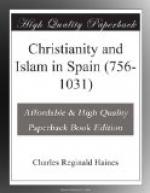[1] Migne’s “Patrologie,” vol. xcvi. p. 814.
There can be no doubt that Christianity was brought very early into Spain by the preaching, as is supposed, of St Paul himself, who is said to have made a missionary journey through Andalusia, Valencia, and Aragon. On the other hand, there are no grounds whatever for supposing that James, the brother of John, ever set foot in Spain. The “invention” of his remains at Ira Flavia in the 9th century, together with the story framed to account for their presence in a remote corner of Spain so far from the scene of the Apostle’s martyrdom, is a fable too childish to need refutation.
The honour of first hearing the Gospel message has been claimed (but, it seems, against probability) for Illiberis.[1] However that may be, the early establishment of Christianity in Spain is attested by Irenaeus, who appeals to the Spanish Church as retaining the primitive doctrine.[2] The long roll of Spanish martyrs begins in the persecution of Domitian (95 A.D.) with the name of Eugenius, bishop of Toledo. In most of the succeeding persecutions Spain furnished her full quota of martyrs, but she suffered most under Diocletian (303). It was in this emperor’s reign that nearly all the inhabitants of Caesar Augusta were treacherously slaughtered on the sole ground of their being Christians; thus earning for their native city from the Christian poet Prudentius,[3] the proud title of “patria sanctorum martyrum.”
[1] Florez, “Espana Sagrada,” vol. iii. pp. 361 ff.
[2] Bk. I. ch. x. 2 (A.D. 186).
[3] 348-402 A.D.
The persecution of Diocletian, though the fiercest, was at the same time the last, which afflicted the Church under the Roman Empire. Diocletian indeed proclaimed that he had blotted out the very name of Christian and abolished their hateful superstition. This even to the Romans must have seemed an empty boast, and the result of Diocletian’s efforts only proved the truth of the old maxim—“the blood of martyrs is the seed of the Church.”
The Spanish Christians about this time[1] held the first ecclesiastical council whose acts have come down to us. This Council of Illiberis, or Elvira, was composed of nineteen bishops and thirty-six presbyters, who passed eighty canons.
[1] The date is doubtful.
Blunt, “Early Christianity,” p. 209,
places it between 314 and
325, though in a hesitating manner.
Other dates given are 300
and 305.
The imperial edict of toleration was issued in 313, and in 325 was held the first General Council of the Church under the presidency of the emperor, Constantine, himself an avowed Christian. Within a quarter of a century of the time when Diocletian had boasted that he had extirpated the Christian name, it has been computed that nearly one half of the inhabitants of his empire were Christians.
The toleration, so long clamoured for, so lately conceded, was in 341 put an end to by the Christians themselves, and Pagan sacrifices were prohibited. So inconsistent is the conduct of a church militant and a church triumphant! In 388, after a brief eclipse under Julian, Christianity was formally declared by the Senate to be the established religion of the Roman Empire.




